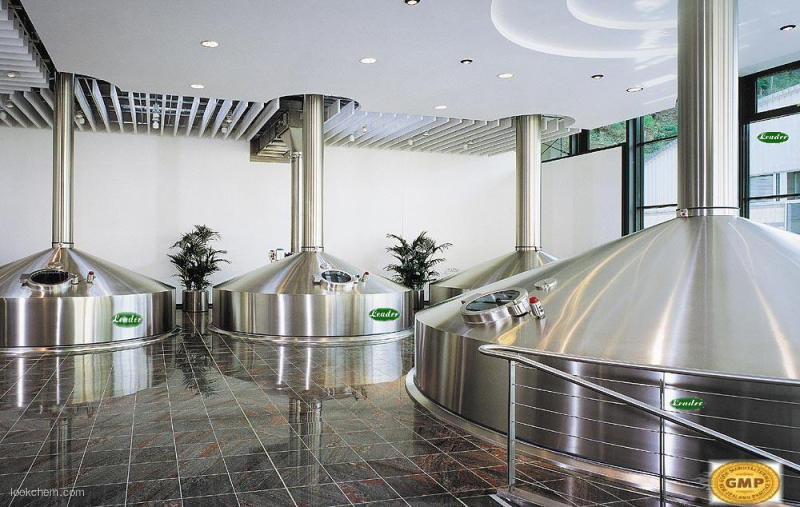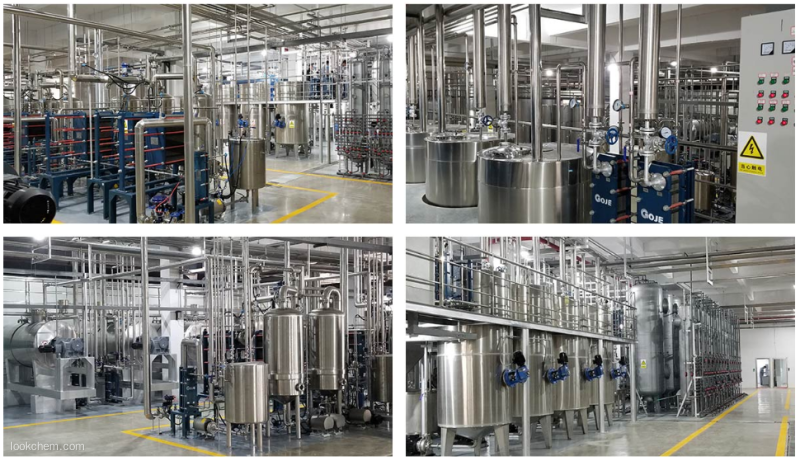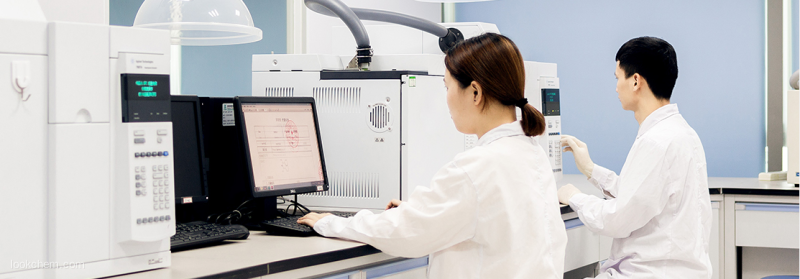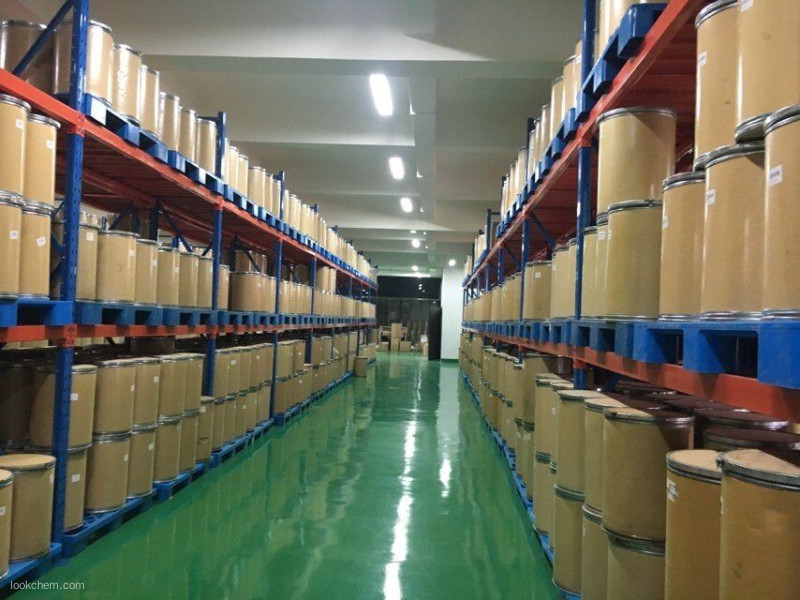PRODUCT DETAILS
| Sodium gluconate Basic information |
| Product Name: |
Sodium gluconate |
| Synonyms: |
Developer,partB;SODIUM GLUCONATE REAGENT;SODIUM GLUCONATE pure;D-Gluconate sodium salt, D-Gluconic acid sodium salt;2,3,4,5,6-Pentahydroxycaproic acid sodium salt, D-Gluconate sodium salt, Sodium D-gluconate;2,3,4,5,6-Pentahydroxycaproic acid sodium salt, D-Gluconate sodium salt, D-Gluconic acid sodium salt, Sodium D-gluconate;glonsen;GLUCONIC ACID SODIUM SALT |
| CAS: |
527-07-1 |
| MF: |
C6H13NaO7 |
| MW: |
220.15 |
| EINECS: |
208-407-7 |
| Product Categories: |
Dextrins、Sugar & Carbohydrates;Biochemistry;Glucose;Sugar Acids;Sugars;stabilizer |
| Mol File: |
527-07-1.mol |
 |
| |
| Sodium gluconate Chemical Properties |
| Melting point |
170-175 °C |
| alpha |
[α]D20 +11~+13° (c=10, H2O) |
| storage temp. |
Store below +30°C. |
| solubility |
H2O: 0.1 g/mL, clear |
| form |
Crystalline Powder |
| color |
White to light beige |
| PH |
7.0-8.0 (100g/l, H2O, 20℃) |
| Water Solubility |
Very soluble in water; sparingly soluble in alcohol; insoluble in ether. |
| Merck |
14,4456 |
| BRN |
3919651 |
| Stability: |
Stable. Incompatible with strong oxidizing agents. |
| CAS DataBase Reference |
527-07-1(CAS DataBase Reference) |
| EPA Substance Registry System |
Sodium gluconate (527-07-1) |
| Safety Statements |
24/25 |
| WGK Germany |
1 |
| RTECS |
LZ5235000 |
| Autoignition Temperature |
>200 °C |
| TSCA |
Yes |
| HS Code |
29181600 |
| Toxicity |
LD50 orally in Rabbit: > 2000 mg/kg |
| Provider |
Language |
| Gluconic acid sodium salt |
English |
| ACROS |
English |
| SigmaAldrich |
English |
| |
| Sodium gluconate Usage And Synthesis |
| Description |
Sodium gluconate is the organic sodium salt of gluconic acid. Sodium gluconate is a chelator that forms stable complexes with various ions and ultimately prevents these ions from engaging in chemical reactions. Gluconates are naturally occurring substances that freely dissociate to the gluconate anion and its respective cations. Being fully biodegradable and non-toxic, it represents an environment friendly alternative to the common chelating agents used in cosmetics such as EDTA. In addition to this, sodium gluconate has a low acute toxicity to aquatic organisms. |
| Chemical Properties |
Sodium gluconate is a white to tan, granular to fine, practically odourless crystalline powder. It is very soluble in water, sparingly soluble in alcohol and insoluble in ether. |
| Originator |
JUNGBUNZLAUER INC. |
| Uses |
Sodium gluconate is used as a natural preservative. It prevents the growth of microbes in our products to keep them safe for our consumers. It also works as a skin-conditioning agent and a chelating agent which helps cleansing products to foam better in hard water. You can often find sodium gluconate in soap, sunscreen, shampoo, toothpaste, hair products, makeup, and a variety of other personal care products.
Sodium gluconate has been used as a component of recording buffer used in two-electrode voltage-clamp (TEVC) recording in Xenopus laevis oocytes. It has also been used as a control for sodium. |
| Definition |
ChEBI: Sodium gluconate is an organic sodium salt having D-gluconate as the counterion. It has a role as a chelator. It contains a D-gluconate. |
| Production Methods |
Sodium gluconate is manufactured by the fermentation of carbohydrate containing the raw material glucose syrup derived from maize. After a crystallisation step, sodium gluconate is separated from the mother liquor by centrifugation, the crystals are dried and then sieved to guarantee the desired granulation. Based on the production process as well as the raw materials used, sodium gluconate is not synthetic natural. |
| Therapeutic Function |
Electrolyte replenisher |
| Biochem/physiol Actions |
Ingestion of sodium gluconate is known to stimulate the production of intestinal butyrate. It is widely used in food, pharmaceutical paper and textile industry. It acts as a chelating agent. Sodium gluconate serves as a detergent in bottle washing formulation. |
| Safety Profile |
Low toxicity by intravenous route. When heated to decomposition it emits acrid smoke and irritating fumes |
| Chemical Synthesis |
The calcium gluconate is added into the reaction kettle. Add sulfuric acid aqueous solution while stirring. After mixing for one hour, let it stand for a while and then get it filtered. The filter residue is CaSO4 and gets it removed. The filtrate is added into the neutralization kettle, and a proper amount of Na2CO3 aqueous solution is added to neutralize it. Finally get sodium gluconate through concentration, filtration and drying. |
| Purification Methods |
Crystallise it from a small volume of H2O (solubility is 59g/100mL at 25o), or dissolve it in H2O and add EtOH since it is sparingly soluble in EtOH. It is insoluble in Et2O. It forms a Cu complex in alkaline solution and a complex with Fe in neutral solution. [cf p 639, Sawyer & Bagger J Am Chem Soc 81 5302 1959, Beilstein 3 I 188.] |
| Regulations |
In Europe, sodium gluconate is listed as a generally permitted food additive (E576) and may be added to all foodstuffs, following the "quantum satis" principle, as long as no special regulation restricts the use.
The US Food and Drug Administration (FDA) assigned sodium gluconate the “generally recognised as safe” (GRAS) status and permitted its use in food without limitation other than current good manufacturing practice.
Sodium gluconate is exempted from the Registration, Evaluation, Authorisation and Restriction of Chemicals (REACH) by means of Commission Regulation (EC) No. 987/2008 of 8 October, 2008 (amending Annex IV). As a consequence thereof, there is no need to register sodium gluconate. |
| |
| Sodium gluconate Preparation Products And Raw materials |
|
|
|
|
|
|
|
|
|
|
|
|
|
|
|
|
About US
Leader Biochemical Group is a large leader incorporated industry manufacturers and suppliers of advanced refined raw materials From the year of 1996 when our factory was put into production to year of 2020, our group has successively invested in more than 52 factories with shares and subordinates.We focus on manufacture Pharm & chemicals, functional active ingredients, nutritional Ingredients, health care products, cosmetics, pharmaceutical and refined feed, oil, natural plant ingredients industries to provide top quality of GMP standards products.All the invested factories' product lines cover API and intermediates, vitamins, amino acids, plant extracts, daily chemical products, cosmetics raw materials, nutrition and health care products, food additives, feed additives, essential oil products, fine chemical products and agricultural chemical raw materials And flavors and fragrances. Especially in the field of vitamins, amino acids, pharmaceutical raw materials and cosmetic raw materials, we have more than 20 years of production and sales experience. All products meet the requirements of high international export standards and have been recognized by customers all over the world. Our manufacture basement & R&D center located in National Aerospace Economic & Technical Development Zone Xi`an Shaanxi China. Now not only relying on self-cultivation and development as well as maintains good cooperative relations with many famous research institutes and universities in China. Now, we have closely cooperation with Shanghai Institute of Organic Chemistry of Chinese Academy of Science, Beijing Institute of Material Medical of Chinese Academy of Medical Science, China Pharmaceutical University, Zhejiang University. Closely cooperation with them not only integrating Science and technology resources, but also increasing the R&D speed and improving our R&D power. Offering Powerful Tech supporting Platform for group development. Keep serve the manufacture and the market as the R&D central task, focus on the technical research. Now there are 3 technology R & D platforms including biological extract, microorganism fermentation and chemical synthesis, and can independently research and develop kinds of difficult APIs and pharmaceutical intermediates. With the strong support of China State Institute of Pharmaceutical Industry (hereinafter short for CSIPI), earlier known as Shanghai Institute of Pharmaceutical Industry (SIPI), we have unique advantages in the R & D and industrialization of high-grade, precision and advanced products. Now our Group technical force is abundant, existing staff more that 1000 people, senior professional and technical staff accounted for more than 50% of the total number of employees, including 15 PhD research and development personnel, 5 master′ S degree in technical and management personnel 9 people. We have advanced equipment like fermentation equipment and technology also extraction, isolation, purification, synthesis with rich production experience and strict quality control system, According to the GMP required, quickly transforming the R&D results to industrial production in time, it is our advantages and our products are exported to North and South America, Europe, Middle East, Africa, and other five continents and scale the forefront in the nation, won good international reputation. We believe only good quality can bring good cooperation, quality is our key spirit during our production, we are warmly welcome clients and partner from all over the world contact us for everlasting cooperation, Leader will be your strong, sincere and reliable partner in China.
Group profiles
Our Factories production lines



Our Factories R&D ability


Our Factories warehouse




 Premiumsupplier
Premiumsupplier 



